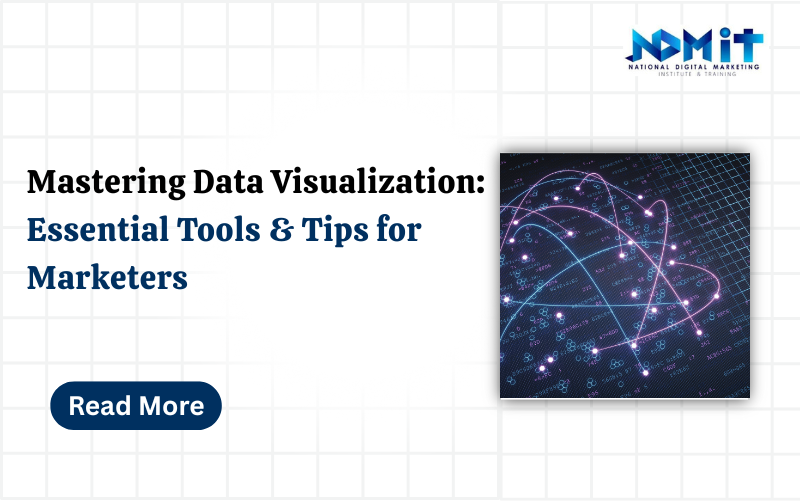
Data Visualization Tools and Tips for Marketers
Data visualization is an essential asset for marketers who want to interpret, present, and leverage data effectively. As marketers, we’re continually tasked with making data-backed decisions that influence customer acquisition, retention, and overall business strategy. When equipped with the right data visualization tools, we can transform raw data into actionable insights that shape our marketing strategies.
Whether you’re just getting started or you’re an experienced marketer, understanding how to effectively visualize your data is key to making informed, data-driven decisions. In this blog, we will explore the latest data visualization platforms, provide actionable tips for marketers, and discuss how data analysis through visualization can benefit your campaigns. We will also highlight how working with can improve your grasp of data visualization in marketing.
Why Data Visualization Matters for Marketers
Data visualization allows us, as marketers, to uncover patterns, trends, and relationships within our data that would be hard to identify otherwise. It transforms complex datasets into visual formats like graphs, charts, and infographics, making the information easier to comprehend and communicate.
In marketing, data analysis is critical, but without the right visualizations, understanding large volumes of data becomes a challenge. By displaying data visually, marketers can:
- Spot trends and patterns in customer behavior.
- Track campaign performance with clear metrics.
- Segment customers based on key attributes.
- Predict future behavior and fine-tune campaigns.
As we took, a heatmap can illustrate the areas of a website that receive the most attention, whereas a pie chart can show the distribution of customers across different age groups. These insights are much more accessible and actionable than raw data alone.
Best Data Visualization Platforms for Marketers
As marketing strategies evolve, so do the data analytics tools we rely on to analyze and visualize information. Let’s review some of the best visualization platforms that are particularly useful for marketers:
- Google Data Studio is a widely-used and intuitive tool for creating visual reports and dashboards. It integrates seamlessly with other Google services like Google Analytics, Google Ads, and Google Sheets. With this platform, marketers can design interactive reports and share them with clients or teams effortlessly.
Key Features: Customizable templates, real-time data updates, integration with Google services, collaboration options.
Best For: Marketers seeking a free, easy-to-use solution for interactive and visually appealing reports. - Tableau is a robust data visualization tool that enables marketers to create a wide range of visual representations from their data. It’s ideal for handling large datasets and providing in-depth analysis.
Key Features: Advanced filtering options, integration with multiple data sources, real-time collaboration, drag-and-drop interface.
Best For: Experienced marketers or data science experts looking for more powerful capabilities to visualize and analyze complex datasets. - Microsoft Power BI is another popular platform for data visualization. It allows marketers to create detailed, interactive dashboards and reports that offer real-time insights into customer behavior and campaign performance.
Key Features: Advanced analytics, integration with Microsoft Office tools, customizable dashboards, real-time data updates.
Best For: Marketers who are already using Microsoft Office tools and want seamless integration. - Looker is a comprehensive data analytics and business intelligence tool that lets marketers visualize and explore data through customizable reports and dashboards. It’s beneficial for understanding customer behavior and tracking marketing metrics.
Key Features: Real-time collaboration, predictive analytics, customizable dashboards.
Best For: Marketers who want to combine data analysis and real-time visualization for deeper insights into customer actions. - D3.js is a JavaScript library used to build dynamic and interactive data visualizations for the web. Though it has a steeper learning curve than other platforms, it provides unmatched flexibility and customization.
Key Features: Highly customizable, open-source, powerful visualization capabilities.
Best For: Developers and marketers with technical experience who need custom-tailored visualizations.
Tips for Effective Data Visualization in Marketing
While the platforms mentioned above are essential for creating data visualizations, it’s just as important to know how to use them effectively. Here are some tips that can help you maximize the impact of your data visualizations:
- Know Your Audience:- Tailor your visualizations to the needs of your audience, whether it’s your marketing team, senior leadership, or clients. Different stakeholders may require different levels of detail or complexity.
- Choose the Right Visualization for Your Data:- Selecting the correct type of chart is key to communicating your message. For instance, line graphs work well for tracking trends over time, while bar charts are better suited for comparing quantities. Keep it simple—don’t use unnecessary visual complexity.
- Keep it Clean and Simple:- Overloading your visualization with excessive data points or elements can lead to confusion. Focus on highlighting the most relevant insights and keep the design simple and easy to understand.
- Enable Interactivity:- Interactive charts and dashboards let users explore the data themselves, offering deeper insights. Interactive features allow users to zoom in on specific data points or filter the data based on certain criteria.
- Use Color Strategically:- Colors are essential in drawing attention to key points in your data. Use contrasting colors to highlight important data, but don’t overwhelm the user with too many colors. A limited color palette ensures clarity and accessibility.
- Provide Context with Annotations:- Annotations are invaluable for explaining key trends and making your visualizations more intuitive. Use them to point out significant data changes or trends that your audience should focus on.
How Data Science Experts Can Improve Your Data Visualization Skills
Even with the right data analytics tools, the true power of visualization lies in how you interpret and apply it. Data science experts play an essential role in helping you make sense of complex data and extract actionable insights. These experts have years of experience in data analysis, and they can guide you through:
- Choosing the right metrics for your marketing goals.
- Building predictive models to forecast customer behavior.
- Analyzing intricate datasets and providing recommendations for improvement.
- Creating data visualizations that align with your business objectives.
For marketers who want to elevate their data visualization game, working with experienced data science professionals can provide the expertise needed to unlock the full potential of your data.
Why NDMIT is the Best Choice for Data Science and Visualization
If you’re looking to gain advanced skills in data visualization, NDMIT offers one of the best data science courses available. This institute provides hands-on learning opportunities, from mastering data analysis tools to applying your skills in marketing contexts. With expert instructors and a well-rounded curriculum, NDMIT ensures you’re prepared to tackle real-world marketing challenges.
Their courses are designed to equip you with practical knowledge in data science, helping you master visualization techniques that directly align with your business and marketing goals. Whether you’re aiming to become a data scientist in marketing or simply want to boost your skills in data analysis, NDMIT is the ideal platform to jumpstart your career.

Frequently Asked Questions
The course typically spans 6 to 12 months, depending on your chosen program, with both full-time and part-time options.
No, you don’t need any prior programming experience. The course starts with beginner-friendly lessons on Python and R.
Topics include data cleaning, machine learning, data visualization, predictive analytics, and applications of data science in marketing.
Yes, upon completion, you’ll receive a certification from NDMIT, which is recognized by industry leaders.
Absolutely! The course is tailored to prepare you for roles like Marketing Data Analyst, Digital Marketing Analyst, and Customer Insight Analyst
Yes, it’s designed for beginners. You'll learn the fundamentals and progress to more advanced topics in data science and marketing.
Graduates typically secure positions in marketing data analysis, digital marketing, customer insights, and more.
Yes, NDMIT provides job placement support, including resume building, interview preparation, and networking opportunities.
NDMIT offers a personalized learning experience, expert mentorship, and a curriculum focused on real-world applications, particularly in marketing.
Yes, NDMIT provides flexible payment plans and financial aid options for eligible students.


